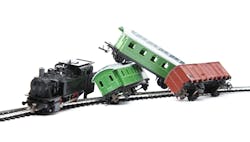How train derailments affect manufacturers & how automation can help
Predictive-analytics company Everstream Analytics has been studying how rail disruptions will affect supply chains. Their data shows an upward trend to more derailments in 2021/2022 compared to previous years, likely due to longer trains and less oversight. Here we chat with Jena Santoro, Everstream’s intelligence solutions manager, to explore how train derailments are affecting manufacturers and prompting interest in modernizing this old form of transport. Take a look...
Smart Industry: Are train derailments increasing in frequency?
Jena: Everstream data finds derailments across rail companies increased considerably in the US between 2021-2022. This is likely due to freight trains getting longer and heavier without adequate safety regulations being put in place to meet such increasing loads. The volumes of cargo being transported by rail have rebounded following pandemic-related disruptions, but staff levels have not yet returned to pre-pandemic levels, meaning safety inspectors are also fewer.
Smart Industry: How do smart, digital tactics affect the world of train shipping?
Jena: Like many other industries, rail freight is also experiencing a shift toward digitization, albeit a gradual one; most notably through the development of autonomous and hybrid train cars. This move toward autonomous trains could strengthen rail freight continuity when situations like railroad strikes arise. At the end of 2022, a US railroad strike threatened to upend supply chains and devastate economic activity. Now, something similar is occurring in Canada, where rail unions representing Canadian National Railway workers have voted on strike action to begin on March 21, should their demands not be met. While strikes serve their purpose, technology could help keep goods moving during such events.
Smart Industry: Are oversight practices that had been performed by human workers getting automated?
Jena: Automation of railroad safety and efficiency could also be impacted by such a shift, as new technologies could monitor thousands of miles of railway lines and curves in a fraction of the time it would take manual labor to do so. Given the continued staffing shortages, a shift toward automation could expand safety inspections and diagnose efficiency gaps more rapidly. But digitization is slow-moving in the rail industry, and it will take a long time before full-scale automation is achieved. For now, rail terminals have begun implementing automated processes in incremental ways, such as capturing gate data or train-position detection to ensure accurate loading and unloading of goods.
Smart Industry: What does this unpredictability with train transport mean for domestic manufacturers? Is this another supply-chain glitch to worry about?
Jena: With the status quo; heightened demand for the movement of goods with shorter delivery times will continue derailments’ upward trajectory. However, most derailments do not lead to devastating consequences as was the recent case in East Palestine, Ohio. Rather, most derailments occur within rail yards and lead to minor cargo-delivery delays.
